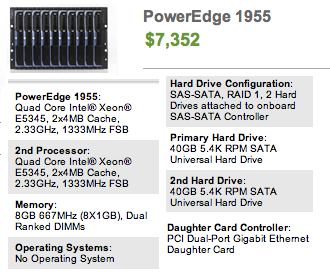Blade servers are self-contained computer servers, designed for high density. Whereas a standard rack-mount server can exist with (at least) a power cord and network cable, blade servers have many components removed for space, power and other considerations while still having all the functional components to be considered a computer. A blade enclosure provides services such as power, cooling, networking, various interconnects and management—though different blade providers have differing principles around what should and should not be included in the blade itself (and sometimes in the enclosure altogether). Together these form the blade system.
In a standard server-rack configuration, 1U (one rack unit, 19" wide and 1.75" tall) is the minimum possible size of any equipment. The principal benefit of, and the reason behind the push towards, blade computing is that components are no longer restricted to these minimum size requirements. The most common computer rack form-factor being 42U high, this limits the number of discrete computer devices directly mounted in a rack to 42 components. Blades do not have this limitation; densities of 100 computers per rack and more are achievable with the current generation of blade systems.
Server blade
The enclosure (or chassis) performs many of the non-core computing services found in most computers. Non-blade computers require components that are bulky, hot and space-inefficient, and duplicated across many computers that may or may not be performing at capacity. By locating these services in one place and sharing them between the blade computers, the overall utilization is more efficient. The specifics of which services are provided and how vary by vendor.
 Power
PowerDuring operation, electrical and mechanical components produce heat, which must be displaced to ensure the proper functioning of the components. In blade enclosures, as in most computing systems, heat is removed with fans.
A frequently underestimated problem when designing high-performance computer systems is the conflict between the amount of heat a system generates and the ability of its fans to remove the heat. The blade's shared power and cooling means that it does not generate as much heat as traditional servers. Newer blade enclosure designs feature high speed, adjustable fans and control logic that tune the cooling to the systems requirements.
At the same time, the increased density of blade server configurations can still result in higher overall demands for cooling when a rack is populated at over 50%. This is especially true with early generation blades. In absolute terms, a fully populated rack of blade servers is likely to require more cooling capacity than a fully populated rack of standard 1U servers.
Cooling
Computers are increasingly being produced with high-speed, integrated network interfaces, and most are expandable to allow for the addition of connections that are faster, more resilient and run over different media (copper and fiber). These may require extra engineering effort in the design and manufacture of the blade, consume space in both the installation and capacity for installation (empty expansion slots) and hence more complexity. High-speed network topologies require expensive, high-speed integrated circuits and media, while most computers do not utilise all the bandwidth available.
The blade enclosure provides one or more network buses to which the blade will connect, and either presents these ports individually in a single location (versus one in each computer chassis), or aggregates them into fewer ports, reducing the cost of connecting the individual devices. These may be presented in the chassis itself, or in networking blades.
 Networking
NetworkingWhile computers typically need hard-disks to store the operating system, application and data for the computer, these are not necessarily required locally. Many storage connection methods (e.g. FireWire, SATA, SCSI, DAS, Fibre Channel and iSCSI) are readily moved outside the server, though not all are used in enterprise-level installations. Implementing these connection interfaces within the computer presents similar challenges to the networking interfaces (indeed iSCSI runs over the network interface), and similarly these can be removed from the blade and presented individually or aggregated either on the chassis or through other blades.
The ability to boot the blade from a storage area network (SAN) allows for an entirely disk-free blade. This may have higher processor density or better reliability than systems having individual disks on each blade.
Storage
Since the blade enclosure provides a standard method for delivering basic services to computer devices, these can be leveraged by other types of devices. Blades providing switching, routing, storage, SAN and fibre-channel access can be inserted into the enclosure to provide these services to all members of the enclosure.
Storage blades can also be used where additional local storage is desired.
Other blades
Blade servers are ideal for specific purposes such as web hosting and cluster computing. Individual blades are typically hot-swappable. As more processing power, memory and I/O bandwidth are added to blade servers, they are being used for larger and more diverse workloads.
Although blade server technology in theory allows for open, cross-vendor solutions, at this stage of development of the technology, users find there are fewer problems when using blades, racks and blade management tools from the same vendor.
Eventual standardization of the technology might result in more choices for consumers; increasing numbers of third-party software vendors are now entering this growing field.
Blade servers are not, however, the answer to every computing problem. They may best be viewed as a form of productized server farm that borrows from mainframe packaging, cooling, and power supply technology. For large problems, server farms of blade servers are still necessary, and because of blade servers' high power density, can suffer even more acutely from the HVAC problems that affect large conventional server farms.
History
Server (computing)
Comparing Servers

1 comment:
your blog is very interesting.thanks for sharing nice information.
Visit More,
Air conditioned server rack
Intelligent server racks
Server rack cooling solutions
Self cooling server rack manufacturers
Self contained server rack with cooling
Post a Comment